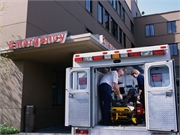WEDNESDAY, July 22, 2020 (HealthDay News) — The COVID-19 pandemic has America’s hospitals on the fiscal ropes, with many facing financial ruin without continued aid from the federal government, a new report predicts.
Average hospital margins across the nation could sink to −7% in the second half of 2020 without further help, with half of all hospitals potentially operating in the red, the American Hospital Association’s new analysis estimates.
“The COVID crisis continues to cripple the financial health of hospitals and health systems,” said Rick Pollack, president and CEO of the American Hospital Association (AHA).
“As today’s analysis shows, this pandemic is the greatest financial threat in history for hospitals and health systems, and is a serious obstacle to keeping the doors open for many,” Pollack added.
U.S. hospitals have had to spend more on personal protective equipment to keep their employees safe from COVID-19, even as revenues have dropped due to state-level lockdowns that canceled all but the most desperately needed services and surgeries.
The analysis, prepared by the financial advisory firm Kaufman, Hall & Associates, considered two potential scenarios — an optimistic slow but steady decrease in COVID-19 cases, and a pessimistic outlook based on periodic surges in infections that would place additional stress on hospital operations.
U.S. hospitals typically operate at an average 3.5% annual profit, “which is very thin” compared with other industries, said Ken Kaufman, managing director and chair of Kaufman Hall.
“In the first quarter of 2020, which included basically maybe two to four weeks of the COVID cases, that median margin fell from 3.5% to a −2%,” Kaufman said. “And then in the second quarter, where COVID cases spread throughout the United States, that median margin for hospitals fell to a −3%.”
The CARES Act passed by Congress is the only reason this dire situation isn’t even worse, Kaufman noted. Without the act’s billions in federal aid, hospital margins would have been −15% in the second quarter of 2020, instead of −3%.
But that aid will end in July without Congressional action, even as COVID-19 continues to ravage U.S. communities.
Even with a slow but steady decline in COVID-19 cases, hospitals face an average loss of −1% for the fourth quarter of 2020, Kaufman said.
If there continues to be periodic surges in COVID-19 — which appears the more likely scenario, given what’s happening — hospitals will face devastating average −11% margins by the fourth quarter, Kaufman said.
“We believe half of America’s hospitals could have negative margins for the end of 2020 under the current circumstances,” Kaufman said.
Grady Health System in Atlanta currently is operating at 105% occupancy due to a COVID-19 surge in Georgia, said Grady CEO John Haupert.
Prior to the new spike, Grady had just started to claw its way back from the dark days of the March shutdown, where the health system saw a 50% reduction in surgeries, 38% fewer emergency visits and a 68% decline in outpatient care, Haupert said.
“With the CARES Act funding through July, we anticipate being at about break even,” Haupert said. “However, this latest surge in volume financially is going to have even more detrimental impact. Our original hope of breaking even now looks like a −3% margin without additional federal funding.”
SBH Health System in the Bronx, N.Y., is in even more dire straits, as it cares for a largely minority population covered by Medicaid and Medicare, said president and CEO Dr. David Perlstein.
Even before the pandemic, SBH was facing its most financially challenging year ever, expecting a 6% operating loss for 2020, Perlstein said.
“Without the CARES Act and the Medicare advance we were able to take, we would have been forced to close our doors during the pandemic,” Perlstein said. “Without the federal support, we would have run out of cash and been forced to shut down the hospital.”
Based on these bleak estimates, Pollack said the AHA is calling on Congress to:
- Fully forgive the advanced Medicare payments that allowed hospital systems like SBH to stay afloat during the first half of this year.
- Provide additional funding for hospitals and emergency providers.
- Enact liability protection for front-line medical providers and facilities.
- Maintain and improve health benefits for all Americans, including more options for the uninsured.
Congress is now bickering over a new pandemic relief package, but negotiators are butting heads over other issues, such as unemployment benefits, a payroll tax cut, and more funding for testing and contact tracing.
“As an anchor institution, we’ve been there for our community through social unrest, through 9/11, through hurricanes, H1N1 and COVID,” Perlstein said of SBH Health System. “In fact, we lost many friends and neighbors, but we also saved many, many more. Without further investment, we will not be there for the next one, and there will be a next one.”
More information
The American Hospital Association has more about COVID-19’s impact on hospital finances.
Copyright © 2025 HealthDay. All rights reserved.

